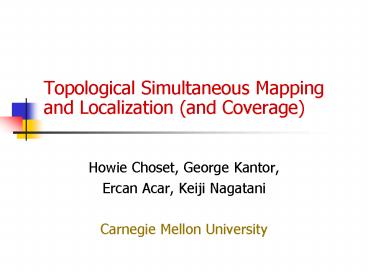Topological Simultaneous Mapping and Localization and Coverage PowerPoint PPT Presentation
1 / 15
Title: Topological Simultaneous Mapping and Localization and Coverage
1
Topological Simultaneous Mapping and Localization
(and Coverage)
- Howie Choset, George Kantor,
- Ercan Acar, Keiji Nagatani
- Carnegie Mellon University
2
Roadmap-Based Path Planning
- Problem
- Start-goal
- Exploration
- Coverage
- Roadmap
- Accessibility
- Connectivity
- Departability
- Distance
3
Point GVG
- Yap, Choset Burdick
GVG in R3 didjdk
No one-dimensional Retract in Punctured R3
HGVG in R3
4
Control Laws
- where
- a and ß are scalar gains
- Null(?G(x)) is the null space of ?G(x)
- (?G(x)) is the Penrose pseudo inverse of ?G(x),
i.e.,
D. Siler C. Kristoff SBP Class
5
Topological Simultaneous Localization Mapping
Node Distance to nearby obstacles Number of
emanating edges Departure angles
Edge Path Length Correspondence
6
Benefits Drawbacks of Topological Maps
- Cannot position in arbitrary locations
- Fails when environments is not topologically
rich - Hyper-symmetric
- Large open spaces
- Scale
- dimension
- geometric size
- Reduce planning problem
- Graph search
- Localization along a line
- Induces a hierarchy of maps for SLAM
- T Topological (Kuipers, Choset)
- F Feature-based (Leonard, Durrant-Whyte)
- L Local/Pixel-based (Morevac, Elfes, Thrun)
- D Dead-reckoning (Borenstein)
- Provides sensor space decomposition useful for
control - Brooks and other Behaviors sense/act
- Brockett Manikonda, Krishnaprasad, and Hendler
Motion Description Languages - Rizzi, Burridge, Koditschek Hybrid Controls
- Kuipers and Choset Topological Maps
7
Hybrid T and F SLAM
4
5
8
Reduce planning problemGraph searchLocalization
along a line
4
5
Series of test increasing in complexity Pass
might be a match Fail not a match
Edge Length Relative distance between meet
points Number of landmarks Position and
covariance of landmarks
Node Distance to nearby obstacles Number of
emanating edges Departure angles
9
Coverage
- Determine a path that passes the robot (or
effector) over all points in a target region
(volume)
Coordinated vs. Random
miketheheadlesschicken.org
Voronoi.sbp.ri.cmu.edu
10
Sensor-based Complete Coverage
Goal Complete coverage of an unknown
environment Cell decomposition Incremental
construction
Time-exposure photo of a coverage experiment
Topological map
11
Hierarchical Decomposition
- Topological (Kuipers, Choset)
- Feature-based (Leonard, Durrant-Whyte)
- Local/Pixel-based (Morevac, Elfes, Thrun)
- Dead-reckoning (Borenstein)
- Reduce dimension to
- One along an edge
- Zero at a node
- Can localize general area for
- localization
12
Induce a Sequence of Control Laws
- Brooks and other Behaviors sense/act
- Brockett Manikonda, Krishnaprasad, and Hendler
Motion Description Languages - Rizzi, Burridge, Koditschek Hybrid Controls
- Kuipers and Choset Topological Maps
- Kantor, Choset, Rizzi, and Koditschek --
Sensorium
13
Sensorium (Sensor-space) Koditscheck
- No way points
- Sensory Driven
- Biological Evidence?
- Low-level
14
Method Failure Modes
Hype-symmetric Environments
Large Open Spaces
Topological Information is not rich
15
Benefits Drawbacks of Topological Maps
- Scale
- dimension
- geometric size
- Reduce planning problem
- Graph search
- Localization along a line
- Induces a hierarchy of maps
- Break-down SLAM into sub-problems T, F, L
- Select among different method
- Provides a useful sensor space decomposition
- topology resolves ambiguities
- Cannot position in arbitrary locations
- Fails when environments is not topologically
rich - Hyper-symmetric
- Large open spaces

